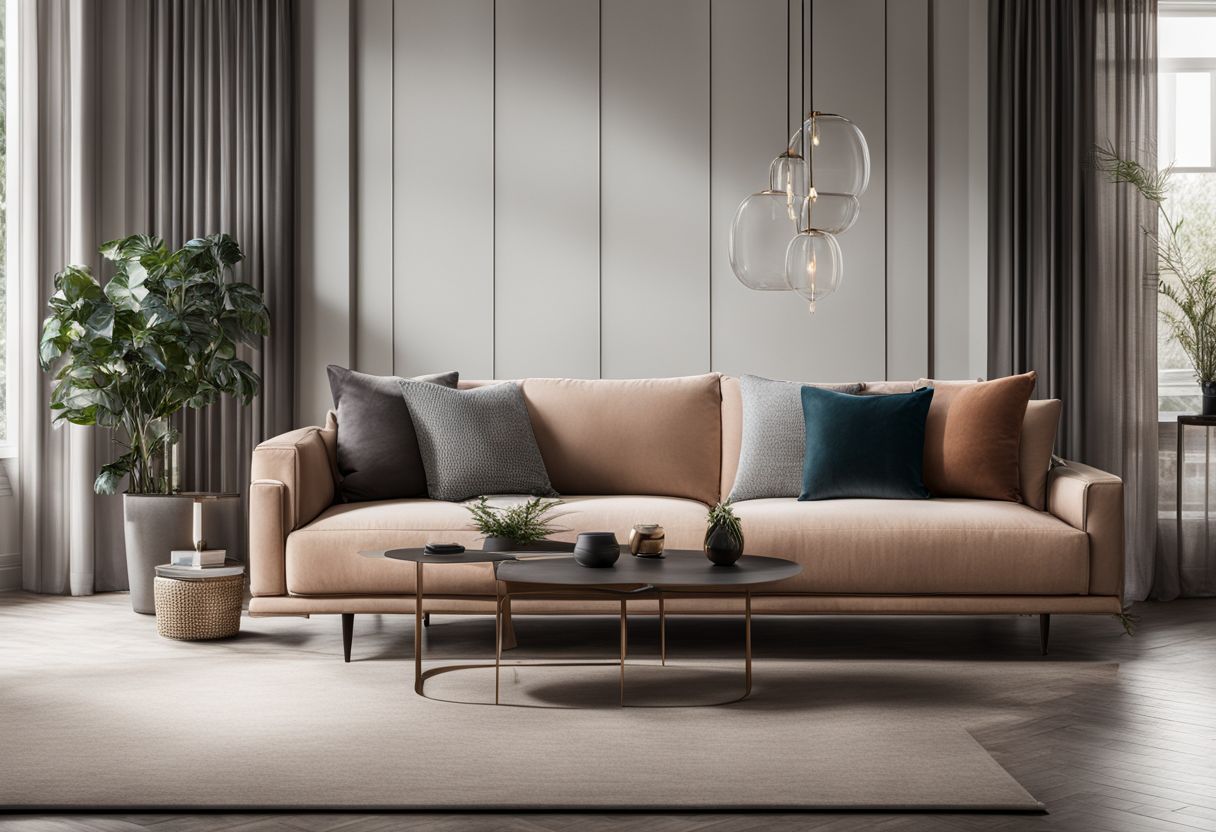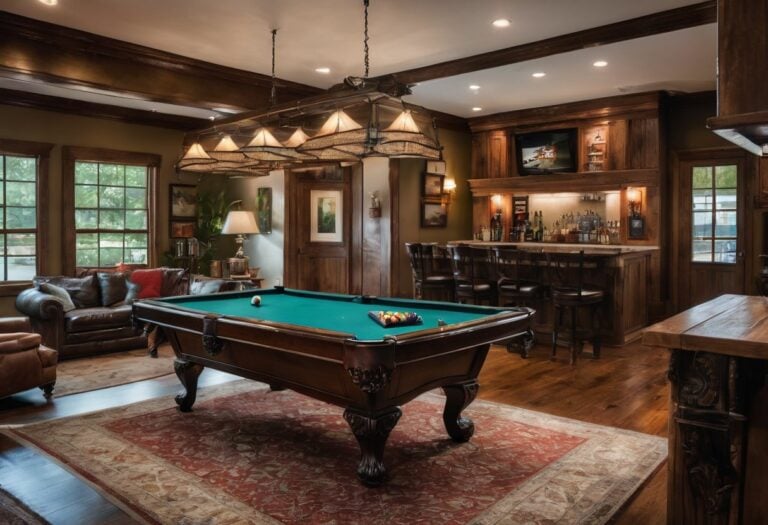Unveiling the Mystery: Why Are Sofas So Expensive?
Staring at price tags and scratching your head, wondering why are sofas so expensive? You’re not alone – it’s a common predicament we’ve all been in. From couches that will set you back $300 to others that cost as much as a modest car (we’re talking over $3,000 here), figuring out exactly what sets them apart can feel like deciphering an unsolvable mystery.
In this enlightening blog post, we’ll dive behind the scenes of production costs and market dynamics to dissect just why these comfy seats often come with substantial prices. Ready for some eye-opening revelations? Let’s take the plunge!
Key Takeaways
- Sofas are expensive because they are made with high – quality materials and involve skilled labor and production costs.
- Customization options, such as unique designs and expensive fabrics, can also increase the price of sofas.
- Brand reputation and marketing play a role in determining sofa prices, with established brands often charging more due to their recognized name and perceived quality.
- Factors like supply and demand, material costs, and trends influence the cost of sofas. Increased demand for furniture, disruptions in the supply chain caused by the pandemic, and import costs contribute to higher prices.
- Investing in an expensive sofa is worth it because it offers durability, comfort, and long – lasting quality compared to cheaper alternatives.
- Strategies for saving money on couch purchases include opting for factory-made options instead of custom-made ones and timing your purchase during sales or special occasions.
The Influence of Design on Sofa Prices

Design plays a significant role in determining sofa prices due to factors such as material costs, labor and production expenses, and customization options.
Material costs
Sofas cost a lot because of what they are made of. The better the material, the more money it takes to make the sofa. For instance, a sofa with high-quality fabric and full cushions will cost more.
When we refill these cushions or change the cover of an old sofa with pricey fabric, it can add up to $4,600! So, you see why sofas have high prices? It’s not just about comfort but also about what goes into making one.
Labor and production costs
Making a sofa takes time and skilled work. This is one reason why sofas cost a lot. I need to pay the workers who make the sofa by hand. They are experts at their job, so they earn high wages.
The way in which each sofa is made also adds to its price tag. Some couches are custom-made or have special designs that take more time and effort. Sofa makers use many different tools and techniques throughout this process, which can add to the overall costs as well.
Customization options
Customizing a sofa boosts its price. This is because I can add personal touches to it. Unique designs command more money than simple ones. I can have intricate patterns that stand out in any room.
The choice of material also matters. Some fabrics cost more than others, and if I pick them, the sofa’s price will go up too! Different finishes offer various looks and feels – some are expensive.
So when it comes to creating my perfect couch, each small change affects the final tag!
The Impact of Brand Reputation and Marketing

Established and reputable furniture brands often come with higher price tags because they have a recognized name and a reputation for quality. When people see a well-known brand, they may be willing to pay more because they believe the product will meet their expectations.
Marketing also plays a crucial role in determining sofa prices. Companies spend time and money developing marketing strategies to create an image of luxury and desirability around their products.
This can influence customers’ perceptions of value and justify higher prices. Additionally, online reputation is vital in today’s business landscape. A company’s reputation can impact real-life behaviors like hiring skilled workers or driving sales.
Word-of-mouth, reviews, and social media presence all contribute to building trust with potential customers. So when it comes to choosing a sofa, considering the impact of brand reputation and marketing can help you understand why some options may be more expensive than others without compromising on quality or style.
Factors That Affect Couch Prices
Different couch materials and their costs, as well as supply and demand dynamics, all play a significant role in determining the price of sofas. Want to know more about what goes into setting sofa prices? Read on!
Different couch materials and their costs
Understanding the costs associated with different couch materials is crucial when planning to purchase a sofa. Here’s a breakdown:
Material TypeAverage CostKey Factors Affecting PriceLeatherHighThe quality of the leather impacts the cost. High-quality leather offers better durability, longevity, and comfort, leading to higher costs.Faux LeatherMediumFaux leather is less expensive than real leather, but its cost can vary based on the quality of the faux leather used.Fabric UpholsteryLow to highThe cost of fabric upholstery can vary greatly. It depends on the quality and type of fabric used. Expensive fabrics often provide better durability and comfort.Wooden CouchesMedium to highWooden couches’ prices can fluctuate due to the type and quality of the wood used. Higher quality woods such as teak or mahogany tend to be more expensive.
When considering your next couch purchase, bear in mind that the material chosen can significantly influence the overall cost.
Supply and demand
When it comes to sofa prices, supply and demand play a big role. Increased demand for furniture, coupled with global supply chain issues caused by the COVID-19 pandemic, has led to higher prices.
As the population grows and more people need couches, the demand for them increases. However, disruptions in the supply chain have made it harder to produce and deliver furniture efficiently, which drives up costs.
Additionally, rising material costs also contribute to the higher price tags on sofas. With these factors at play, it’s important to understand how supply and demand impact couch prices when considering a purchase.
Understanding the Value of a Couch Purchase
A couch purchase is an investment in durability, comfort, and long-lasting quality. Discover why it’s worth spending more for a premium sofa that will stand the test of time.
Durability and longevity
When it comes to sofas, durability and longevity are essential factors to consider. Expensive sofas justify their high cost by using premium materials that offer long-lasting durability.
These high-quality materials ensure not only comfort but also the ability to withstand daily use without showing signs of wear and tear. For example, Chesterfield sofas, known for their environmental friendliness, are more expensive because they can last a lifetime due to their superior craftsmanship and construction.
So when choosing a couch, it’s important to prioritize durability and longevity for better value in the long run compared to cheaper alternatives.
Comfort and support
When it comes to comfort and support, investing in a high-quality couch is important. Expensive sofas often provide better comfort because they are made with top-notch materials. These materials are chosen for their durability and ability to retain shape over time.
So, even though you might pay more upfront, you’ll get a comfortable and supportive sofa that will last longer. It’s worth considering these factors when making your purchase decision.
Remember that the construction of the sofa also plays a role in its comfort and support. Well-made couches have sturdy frames that can withstand regular use without losing their shape or becoming saggy.
Additionally, high-quality cushions and padding make sitting or lying down on the sofa a pleasant experience.
The Role of Market Forces in Couch Prices
High demand and low supply can drive up the prices of sofas, while trends and design innovations also play a significant role. Read on to uncover the factors that impact couch prices and how market forces shape their cost.
High demand and low supply
The cost of sofas is often driven by high demand and low supply. There are many people looking to buy sofas, but there aren’t enough available to meet the demand. This creates a situation where sellers can charge higher prices because they know that people are willing to pay more for limited options.
Additionally, factors like import costs, shipping expenses, and exchange rates further contribute to the high prices of imported furniture. As a result, buyers may face difficulty finding affordable options due to market dynamics and scarcity of supply.
In recent times, supply chain issues have also caused delays in deliveries and added further pressure on sofa prices as the surge in demand for furniture continues.
Impact of trends and design innovations
As an adult, it’s important to understand how trends and design innovations impact the price of sofas. Companies are now focusing on offering standardized products instead of customizing items.
For example, IKEA asks customers to assemble their own furniture as part of their cost leadership strategy. This helps reduce production costs and ultimately leads to lower prices for consumers.
Changes in the competitive market also play a role in driving down sofa prices, as companies strive to offer more affordable options. Entrepreneurial innovation is considered a disruptive force that drives economic growth, bringing new ideas and technologies into the market.
Strategies to Save on Couch Purchases
Save money on your next couch purchase by considering factory-made options, timing your purchase during sales, and exploring second-hand options. Learn more about these strategies to find the perfect sofa at a fraction of the cost! Read on to save big on your living room furniture.
Opting for factory-made over custom-made
I think one way to save money when buying a sofa is to choose a factory-made one instead of getting a custom-made couch. Factory-made sofas are usually more affordable because they are mass-produced and made with lower-priced construction materials. This means that the overall cost is lower, and you can get a good quality sofa without breaking the bank. Plus, you can still find stylish and comfortable options among factory-made sofas. So, if you’re on a budget, consider looking into factory-made couches as a way to save some money.
Timing your purchase and shopping sales
I have found that one way to save money when buying a couch is by timing your purchase and shopping sales. Here are some tips to help you get the best deals:
- Take advantage of end-of-season sales: Furniture stores often offer discounts on sofas when they are trying to make room for new inventory. The end of winter and end of summer are mentioned as favorable times to buy furniture.
- Shop during holidays and special occasions: Many retailers offer sales and promotions during holidays like Presidents Day, Memorial Day, Labor Day, and Black Friday. Keep an eye out for these opportunities to save money on your couch purchase.
- Consider clearance or outlet stores: These stores often carry discounted furniture that may be last season’s models or have minor imperfections. You can find great deals on couches by exploring these options.
- Sign up for retailer newsletters or follow them on social media: Many furniture stores send out exclusive offers and promotions to their email subscribers or followers. By staying informed, you can be among the first to know about upcoming sales and discounts.
Considering second-hand options
When looking for affordable couches, I have found that considering second-hand options can be a smart choice. Not only can it save you a small fortune, but it is also kinder to the environment. By opting for used furniture, you are making a sustainable choice for your home decor.
How Material Choice Affects Sofa Prices
The choice of material significantly impacts the prices of sofas as different materials have varying costs and production processes.
Leather and faux leather
Leather and faux leather are two popular choices for sofa materials. Leather sofas tend to be more expensive than fabric ones, while faux leather is a more affordable alternative to genuine leather.
Faux leather has a similar look and feel to real leather, but it is made from synthetic materials like vinyl. Leather sofas require proper care to prevent aging and maintain their quality, which can add to the overall cost.
On the other hand, fabric sofas are generally less expensive than leather sofas. When choosing a sofa material, consider factors like durability, comfort, and price range that best suit your needs.
Fabric upholstery
When it comes to choosing the fabric upholstery for your sofa, there are a few factors that can affect the price. Wool and silk fabrics tend to be more expensive compared to other materials used for upholstery.
However, finding the right balance between durability and value is important when making your decision. It’s essential to consider how often the sofa will be used and if you have kids or pets that may cause wear and tear.
By understanding these factors, you can make an informed choice in selecting a fabric that meets your needs without breaking the bank.
Wooden couches
Wooden couches are a popular choice for sofas, and they can be more expensive than other types of couches. This is because the type and quality of wood used can greatly impact the price.
Hardwoods like oak or maple are commonly used for wooden couch frames, and these woods tend to be more costly. The cost of the wood itself is a big factor in the higher price of wooden couches compared to those made with other materials.
So, if you’re looking for a wooden couch, keep in mind that the material and build contribute to its higher price tag.
The Importance of Skilled Workers in Sofa Production
Skilled workers play a crucial role in sofa production. They are the expert craftsmen who bring furniture designs to life. These skilled laborers have extensive knowledge and experience in furniture manufacturing, allowing them to create high-end pieces with exceptional craftsmanship.
Their expertise is especially important when it comes to upholstery techniques, ensuring that sofas are properly constructed and finished.
Quality control is another aspect where skilled workers shine. They meticulously check every detail of the sofa production process, making sure that each piece meets durability standards and passes quality assurance tests.
By having skilled workers involved in every step of the production process, furniture companies can guarantee that their sofas are made to last.
The use of premium upholstery materials also adds to the cost of sofas. Skilled workers know how to work with these materials effectively, maximizing their potential and creating luxurious finishes.
With their expertise, they can transform raw materials into beautiful pieces of furniture.
It’s important not to underestimate the value that skilled workers bring to sofa production. Their attention to detail, craftsmanship, and knowledge ensure that customers get a high-quality product for their money.
So next time you’re shopping for a sofa, remember the importance of skilled labor behind its creation!
Conclusion
Sofas may seem expensive, but there are some key factors that contribute to their high price. Premium materials, labor and production costs, customization options, and brand reputation all play a role in the cost of sofas.
Additionally, market forces such as supply and demand and trends also impact prices. Understanding these factors can help consumers make informed decisions when purchasing a sofa and explore strategies to save money without compromising on quality or style.
FAQs
1. Why are sofas so expensive?
Sofas can be expensive due to the quality of materials used, craftsmanship involved in production, and additional features or customization options that increase the cost.
2. Are there cheaper alternatives to buying an expensive sofa?
Yes, there are cheaper alternatives such as purchasing secondhand sofas, opting for simpler designs without extra features, or considering budget-friendly brands.
3. How long do sofas usually last?
The lifespan of a sofa depends on factors like usage, maintenance, and quality. On average, a well-maintained sofa can last around 7-15 years.
4. Can I negotiate the price of a sofa with the seller?
In some cases, you may be able to negotiate the price of a sofa by discussing discounts or asking for promotions during sales events. It’s worth trying if you’re interested in buying.
5. Is it worth investing in an expensive sofa?
Investing in an expensive sofa can be worthwhile if you prioritize durability, comfort, and long-term satisfaction with your purchase. However, personal preferences and budget should also be considered before making a decision.







